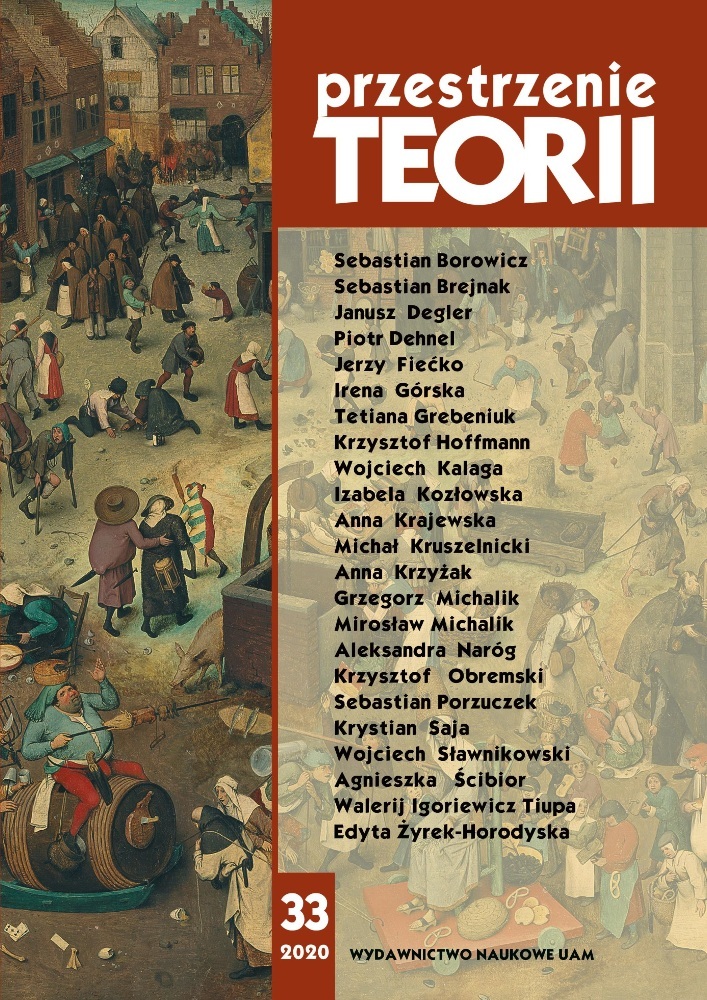Abstrakt
The article examines the specifics of the reader’s reception of Stanisław Lem’s novel Solaris in the context of indeterminacy, and the openness of the work to interpretation. The paper examines literary approaches to the formation of meaning in the process of reading this novel, in particular those implemented in Manfred Geier and Istvan Jr. Csicsery-Ronay works. Marie-Laure Ryan’s adaptation of the theory of possible worlds to literary analysis is employed as the methodological basis of my research. On the one hand, the effect of indeterminacy corresponds to the fantastic nature of the conditionality of Lem’s novel. Indeed, the key issue of the work – the encounter of humans with the unknown – requires the author to apply the potential of secrecy. On the other hand, this highly literary work (as well as Andrei Tarkovsky’s film adaptation) is endowed with multiple and ambiguous semantic codes that appeal to the depths of human consciousness and the unconscious. These codes cannot be interpreted unambiguously and, therefore, also provoke a state of uncertainty in the reader. In the textual actual world, semantic codes produce indeterminacy. They are linked to the essence of the single inhabitant of the Solaris, the Ocean, and phantoms created by it who visit the Station. In the novel protagonist’s Kris Kelvin personal world, the state of indeterminacy is associated with the existential essence of his relationship with his beloved Rheya and the problem of making contact with extraterrestrial intelligence. The surreal imagery of Kris’s dreams and visions provide for possible interpretations of the semantic codes of his world.
Bibliografia
Botz-Bornstein T., Films and Dreams: Tarkovsky, Bergman, Sokurov, Kubrick, and Wong Kar-Wai, Lexington 2007.
Csicsery-Ronay I.Jr., The Book Is the Alien: On Certain and Uncertain Readings of Lem’s “Solaris”, “Science-Fiction Studies” 1985, no. 12, (1), p. 6–21.
Doležel L., Heterocosmica. Fiction and possible worlds, Baltimore 1998.
Eco U., The Role of the Reader: Explorations in the Semiotics of Texts, Bloomington 1984.
Geier M., Stanislaw Lem’s Fantastic Ocean: Toward a Semantic Interpretation of “Solaris”, “Science-Fiction Studies” 1992, no. 19 (2), p. 192–218.
Gutiérrez-Jones C., Stranded Contacts: The Transformative Potential of Grief in Stanislaw Lem’s Solaris, [in:] Suicide and Contemporary Science Fiction, Cambridge 2015, p. 44–77.
Hayles K.N., Chaos as Dialectic: Stanislaw Lem and the Space of Writing, “Chaos Bound: Orderly Disorder in Contemporary Literature and Science”, Ithaca and London 1990, p. 115–140.
Jarzebski J., Stanislaw Lem: Rationalist and Visionary, przeł. Franz Rottensteiner, “Science-Fiction Studies” 1977, no. 4, p. 110–126.
Krywak P., Fantastyka Lema: droga do “Fiaska”, Kraków 1994.
Lem S., Fantastyka i futurologia, vol. 2, Kraków 1970.
Lem S., Solaris, Harvest Books 1987.
Lewis D., Counterfactuals, Cambridge 1973.
Pavel G.T., Fictional worlds, Cambridge 1986.
Petric V., Tarkovsky’s Dream Imagery, “Film Quarterly” 1989, no. 43 (2), p. 28–34.
Ronen R., Possible Worlds in Literary Theory, Cambridge 1994.
Ryan M.-L., Possible Worlds, [in:] Living Handbook of Narratology, <https://www.lhn.uni-hamburg.de/node/54.html> [retrieved: 12.01.2020].
Ryan M.-L., The Modal Structure of Narrative Universes, “Poetics Today” 1985, no. 6 (4), p. 717–756.
Ryan M.-L., Bell A., Introduction: Possible Worlds Theory Revisited, [in:] Possible Worlds Theory and Contemporary Narratology, eds. A. Bell and M.-L. Ryan, Lincoln and London 2019, p. 1–43.
Swirski P., Solaris! Solaris. Solaris?, [in:] The Art and Science of Stanislaw Lem, ed. P. Swirski, Montreal and Kingston–London–Ithaca 2008, p. 172–179.
Todorov T., The Fantastic: A Structural Approach to a Literary Genre, Cleveland–London 1973.
Жижек C., „Вещь из внутреннего пространства”, „Художественный журнал” 2001, no. 32, <http://www.guelman.ru/xz/362/xx32/xx3225.htm> [retrieved: 12.01.2020].
Кияк I.Б., Жанрові особливості фантастики і футурології Станіслава Лема, Автореферат дисертації на здобуття наукового ступеня к.ф.н., Київ 2001.
Савельева Е.А., Картина П. Брейгеля «Охотники на снегу» как метафизический сон о Земле в фильме А. Тарковского «Солярис», „Вестник Ленинградского государственного университета имени А.С. Пушкина: Научный журнал” 2015, vol. 2, no. 3, p. 233–241.
Салынский Д.Л., Киногерменевтика Тарковского, Москва 2009.
Licencja
Autorzy
Autorzy tekstów przyjętych do publikacji w czasopiśmie „Przestrzeniach Teorii” są zobowiązani do wypełnienia, podpisania i odesłania na adres redakcji umowy o udzielenie nieodpłatnej licencji do utworów, z zobowiązaniem do udzielania sublicencji CC.
Zgodnie z umową, autorzy tekstów opublikowanych w czasopiśmie „Przestrzeniach Teorii” udzielają Uniwersytetowi im. Adama Mickiewicza w Poznaniu niewyłącznej i nieodpłatnej licencji oraz zezwalą na użycie sublicencji Creative Commons Attribution-NonCommercial-NoDerivatives 4.0 International (CC BY-NC-ND 4.0).
Autorzy zachowują prawa do dalszego, swobodnego rozporządzania utworem.
Autorzy, którzy wykorzystują w swoim tekście cudze utwory (np. ilustracje, fotografie) proszeni są o dostarczenie do redakcji czasopisma zgodę na publikację od uprawnionych podmiotów.
Użytkownicy
Zainteresowani użytkownicy internetu uprawnieni są do korzystania z utworów opublikowanych po 2015 roku „Przestrzeniach Teorii” tylko w calach niekomercyjnych, pod następującymi warunkami:
- uznanie autorstwa - obowiązek podania wraz z rozpowszechnionym utworem, informacji, o autorstwie, tytule, źródle (odnośniki do oryginalnego utworu, DOI) oraz samej licencji;
- bez tworzenia utworów zależnych - utwór musi być zachowany w oryginalnej postaci, nie można bez zgody twórcy rozpowszechniać np. tłumaczeń, opracowań.
Do wszystkich tekstów opublikowanych przed 2015 r. prawa autorskie są zastrzeżone.
Inne
Uniwersytet im. Adama Mickiewicza w Poznaniu zachowuje prawo do czasopisma jako całości (układ, forma graficzna, tytuł, projekt okładki, logo itp.).
